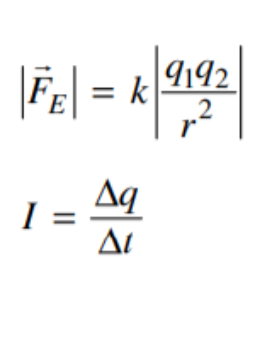
Unit 8 Overview: Electric Charge and Electric Force
2 min read•september 9, 2021
Peter Apps
Peter Apps
Electricity is everywhere, powering our daily lives. While difficult to visualize, the basics of electricity rely on the idea of and the interactions of charged objects.

Image courtesy of Giphy.
This unit introduces the concepts of and . These concepts serve as the basis for developing in Unit 9 as well as being foundational to the topics in AP Physics 2. These topics will account for ~4-5% of the AP exam questions and will take approximately 3-5 45 minute class periods to cover.
Applicable Big Ideas in Unit 8
Big Idea #1: Systems - Objects and systems have properties such as mass and charge. Systems may have an internal structure.
Big Idea #3: Force Interactions - The interactions of an object with other objects can be described by forces.
Big Idea #5: Conservation - Changes that occur as a result of interactions are constrained by conservation laws.
Key Concepts for Unit 8 🔑
Charge (q)
(Fe)
, ,
Key Equations for & 🗝

🎥Watch: AP Physics 1 - Unit 8 Streams
Key Terms to Review (9)
Conservation of Charge
: The principle that states that the total electric charge in a closed system remains constant over time.Electric charge
: Electric charge is a fundamental property of matter that determines how it interacts with electric fields. It can be positive or negative.Electric Circuits
: Electric circuits are pathways through which electricity flows. They consist of components such as wires, resistors, capacitors, and batteries connected in a closed loop.Electric Force
: Electric force refers to the attractive or repulsive force between two charged objects. Like charges repel each other, while opposite charges attract each other.Electron
: An electron is a subatomic particle that carries a negative charge and orbits around the nucleus of an atom.Electrostatic Force
: Electrostatic force refers to the attraction or repulsion between electrically charged objects due to their electric charges.Magnetism
: Magnetism is a force that attracts or repels certain materials, such as iron or steel. It is caused by the movement of electric charges.Neutron
: A neutron is a subatomic particle that has no charge and is found in the nucleus of an atom.Proton
: A proton is a subatomic particle found in the nucleus (center) of an atom. It has a positive electrical charge and contributes to the mass of the atom.Unit 8 Overview: Electric Charge and Electric Force
2 min read•september 9, 2021
Peter Apps
Peter Apps
Electricity is everywhere, powering our daily lives. While difficult to visualize, the basics of electricity rely on the idea of and the interactions of charged objects.

Image courtesy of Giphy.
This unit introduces the concepts of and . These concepts serve as the basis for developing in Unit 9 as well as being foundational to the topics in AP Physics 2. These topics will account for ~4-5% of the AP exam questions and will take approximately 3-5 45 minute class periods to cover.
Applicable Big Ideas in Unit 8
Big Idea #1: Systems - Objects and systems have properties such as mass and charge. Systems may have an internal structure.
Big Idea #3: Force Interactions - The interactions of an object with other objects can be described by forces.
Big Idea #5: Conservation - Changes that occur as a result of interactions are constrained by conservation laws.
Key Concepts for Unit 8 🔑
Charge (q)
(Fe)
, ,
Key Equations for & 🗝

🎥Watch: AP Physics 1 - Unit 8 Streams
Key Terms to Review (9)
Conservation of Charge
: The principle that states that the total electric charge in a closed system remains constant over time.Electric charge
: Electric charge is a fundamental property of matter that determines how it interacts with electric fields. It can be positive or negative.Electric Circuits
: Electric circuits are pathways through which electricity flows. They consist of components such as wires, resistors, capacitors, and batteries connected in a closed loop.Electric Force
: Electric force refers to the attractive or repulsive force between two charged objects. Like charges repel each other, while opposite charges attract each other.Electron
: An electron is a subatomic particle that carries a negative charge and orbits around the nucleus of an atom.Electrostatic Force
: Electrostatic force refers to the attraction or repulsion between electrically charged objects due to their electric charges.Magnetism
: Magnetism is a force that attracts or repels certain materials, such as iron or steel. It is caused by the movement of electric charges.Neutron
: A neutron is a subatomic particle that has no charge and is found in the nucleus of an atom.Proton
: A proton is a subatomic particle found in the nucleus (center) of an atom. It has a positive electrical charge and contributes to the mass of the atom.
Resources
© 2024 Fiveable Inc. All rights reserved.
AP® and SAT® are trademarks registered by the College Board, which is not affiliated with, and does not endorse this website.